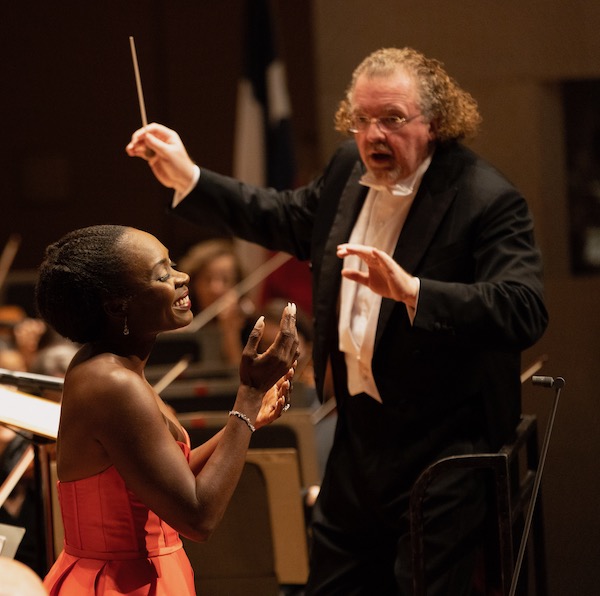Rachmaninoff, Connesson works provide the highlights with Denève, DSO

The Dallas Symphony Orchestra, under the baton of French conductor Stéphane Denève, led off this week’s program with two works inspired by very different literary texts.
Guillaume Connesson’s “Celephais,” from his Cities of Lovecraft, is an homage to H.P. Lovecraft’s vision of a drug-influenced dreamscape. Connesson, whom Denève described from the stage as a friend, is a 50-something French composer who reports that among his influences are Wagner and Strauss, Debussy and Ravel, Reich and Adams—and James Brown.
“Celephais,” from 2017, was new to the DSO, but they performed its fast-moving, atmospheric challenges with admirable skill. This is music that embraces the tonal, with lots of coloristic busyness in the large orchestra’s strings contrasted with percussion effects such as a slapstick. The exuberant piece got a warmer reception from the audience than is often granted “new music” in Dallas.
Samuel Barber’s Knoxville: Summer of 1915, was like the Connesson, but far more surprisingly, a DSO premiere. It is inspired by James Agee’s short prose piece of the same name, which like Connesson’s Lovecraftian influence, is a sort of nostalgic dreamscape. Agee recalls being a small, “well-beloved” boy, on an idyllic summer night, lying on quilts in the backyard with his family. Annoyingly, however, this text was reproduced nowhere in the program, nor projected in supertitles, leaving many audience members guessing.
The performance featured Trinidadian soprano Jeanine De Bique, resplendent in an orange-red strapless ballgown. De Bique’s online presence reveals that she is best-known for her performances of the music of Baroque composers such as Handel.
This makes perfect sense, because while De Bique’s approach is colorful, tone attractive, and expression thoughtful, hers is not a big voice. In the Meyerson Thursday, she was frequently inaudible even with a moderately-sized orchestra, and Denève’s balancing didn’t help. That’s unfortunate since this is a jewel of a piece, with Barber’s characteristic lushness underscoring the poignancy of Agee’s reflective text.
Sergei Rachmaninoff’s Symphonic Dances closed out the evening, with its glorious excesses. Here, the crisp precision and restrained expressiveness of Denève’s conducting were most clearly in evidence. He eschewed outrageous gestures in favor of a more subtle approach, which brought out superlative playing from the DSO. Rachmaninoff was no doubt one of the greatest melodists ever to take pen to staff paper, and the first movement of the Dances demonstrates this melodic gift brilliantly. In the DSO’s skillful hands, the lush tune danced around the orchestra, from oboe to alto saxophone to strings, each iteration more gorgeous than the last.
There was bracing playing in the strings, a well-executed violin solo by Alexander Kerr, and a bevy of woodwind solos including a particularly gorgeous one by principal oboe Erin Hannigan characterized the second movement. In the third and final section, the DSO’s percussion section under the leadership of George Nickson shone. This movement features perhaps the jauntiest iteration of the Dies Irae ever, and the orchestra was there for it, wrapping up with a cacophony of joyful noise for a guaranteed and much-deserved standing ovation.
The Dallas Symphony will repeat the program 7:30 p.m. Friday and Saturday at the Meyerson Symphony Center. dallassymphony.org


